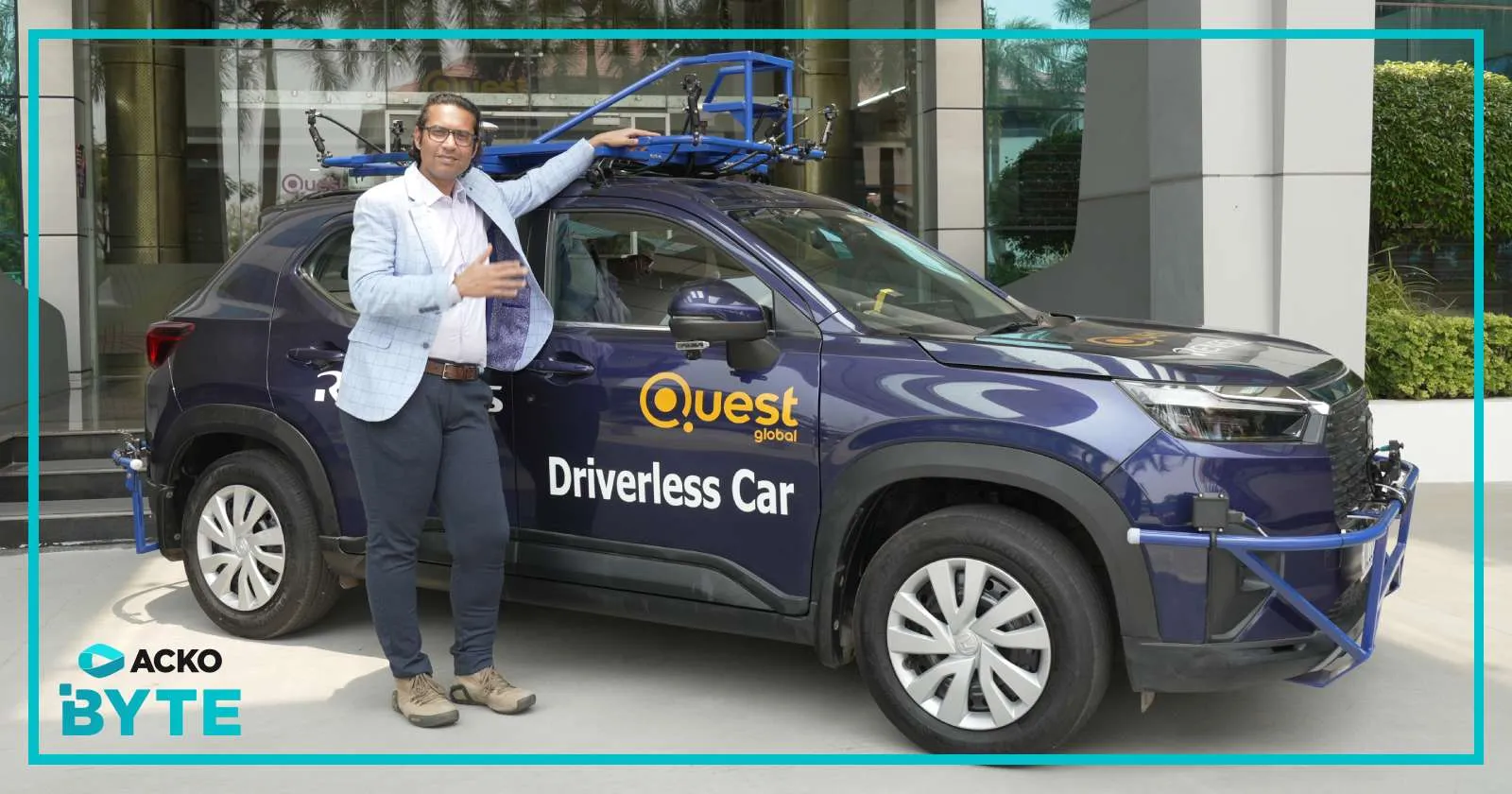
Kamal Deep Sethi, pictured with the Quest Global QUAD test platform which can perform certain autonomous driving tasks under supervision.

Share Post

Kamal Deep Sethi, pictured with the Quest Global QUAD test platform which can perform certain autonomous driving tasks under supervision.
Acko Drive recently had the chance to visit Quest Global, a firm developing ADAS and autonomous driving solutions at its campus in Thiruvananthapuram. The main attraction was the QUAD, a test vehicle outfitted with multiple sensors and prototype equipment that the company is working on. You won’t see this out and about on Indian streets, since it can only be operated on private property, but it gives us a taste of what might show up in production vehicles from major manufacturers in the future.
We caught up with Kamal Deep Sethi, Global ADAS and Autonomous Mobility Centre of Excellence Leader at Quest Global, to talk about the company’s work, where it sees opportunities for innovation, and the challenges of bringing such features to cars that might one day drive on Indian roads.
Tell us a little about quest global and its journey with ADAS
Sethi: Quest Global is a 27-year-old pure-play engineering services organisation. Our biggest advantage is that we can leverage so much across automotive and our other verticals, including medtech, aerospace, and even railways. It was not a big transformation when we moved into the automotive industry. For example in 2007-8, we were using Nvidia gaming GPUs for image processing on MRI and ultrasound machines.
ADAS is actually based on an array of sensors. We process that sensor information and use AI algorithms, all running on a small ECU (Electronic Control Unit). It’s the same as HPC (High Performance Computing). Our work with railways already involved high-tension electric systems, so it was easy to move from there to here.

Can you talk about the QUAD demo car and what you have been working on?
Sethi: We are purely a technology company; we are the enablers, or I would say accelerators, for our customers who are OEMs and Tier I manufacturers in various automotive industries. Our 4,000-strong team in automotive and our 20,000+ people across Quest Global serve not only Indian problems but also cater to the global market.
Let’s talk about our vehicle now. We are calling it QUAD - the Quest Global Autonomous Driving pilot. We have created this platform which can not only serve the basic purpose of L2 but also going forward it can move into L2+, L3, and L4. That’s the level of autonomy we have targeted. We have kept it modular – when we talk about ADAS or autonomous driving, there are various building blocks. One of these is the sensors. For L2 in the Indian market, vehicles generally have five 3D radars, one long-distance front camera, and four surround cameras. This is the typical sensor suite for L2. However in this car, we have not only these sensors but also additional ones which are required to go from assisted to fully autonomous driving. We use five 4D radars – the major difference is they can measure the heights of objects.
We are not working with only the data traditionally sensed by L2 vehicles, which can create an “object list”, but rather on point cloud data. That is much denser and lets us achieve lots of other things. We also have six cameras on the top of the vehicle for 360-degree long distance perception. Then there are additional surround view cameras, plus one or two more for referencing. So in total – 11 cameras and five radars.
What’s very important for L3 and beyond is localisation. GPS typically has an error rate of 3-5m so we are able to tell which road we are on but not which lane. We need accuracy in the range of 3-5cm, and we are able to achieve that with GNSS sensors. This is a combination of GPS plus IMU (Inertial Measurement Unit). That gives us yaw, pitch and roll information which translates into data about terrain and elevation angles. This not only serves for L2 and L3, but also as a possible route for L4 and L5.
How is this going to be relevant to the Indian market?
Sethi: We have seen up to L2 ADAS features on Indian roads, but you can only use something like ACC (adaptive cruise control) about 35 percent of the time. All this technology was developed for German or US infrastructure, for example, and now we are adapting algorithms to Indian scenarios. It’s still not done fully. For example, ADAS at present actually depends a lot on detecting lane lines [painted on roads]. The sensors we’re using, like 4D radar, and the dense point cloud data, lets us detect road boundaries instead of only detecting lanes. We don’t have to depend on such markers. The additional data we can capture shows speed breakers and intersections.
Some L2 ADAS features can only be used when driving faster than 40kmph. It is very important to have L2 features that are specific to Indian scenarios. In my opinion, it will take some time to fully achieve L3 in Indian conditions, but till then, we will see a lot of advancements specifically catering to Indian needs. Autonomous parking, moving 50-70m autonomously in order to park, is quite possible in the next 3-5 years. You will see things changing quite rapidly here.
How much automation will play out in India, and what does the near future look like?
Sethi: Roads are structured environments; you are driving on [defined concrete pathways]. However, other traffic participants exhibit different, abrupt behaviours. A person can dart out from the left or right; a vehicle can cut in from any side. So that’s unstructured behaviour in a structured environment. For passenger cars, it will take time to get to L3.
On the other hand there are other markets where driving behaviour is more conducive, for example at construction and mining sites. Here, we can employ L3+; complete autonomy where a vehicle can actually go into a site and perform various operations. These are very unstructured environments, but there is structured behaviour. We can easily develop autonomous vehicles to cater to those needs.
Another application is commercial vehicles; specifically trucks. In the US, there are huge distances between states. Drivers can experience fatigue and they have limited time in which they have to reach a destination. L3+ or L4 tech has been introduced for safety. You will see this in commercial vehicles before passenger vehicles.
What will it take to achieve L4 autonomy?
Sethi: The difference between L3 and L4 is that there are more and more complex algorithms handling safety. L3 requires the driver to be primarily in their seat, but driving can be hands free. A person can take their hands off the wheel, but they have to be paying attention. For L4, the driver can take their mind off the road for some time to rest or even sleep in some cases.
Do OEMs plan to roll out such features in India? Are we even ready for L3?
Sethi: In terms of features, moving from L2 to L3 mainly adds autonomous lane changing. L2 is only longitudinal driving, and L3 involves lateral shifting as well. The second aspect is in terms of liability.
We need to understand that there is a liability clause when it comes to autonomous driving. In L2, the liability lies with the driver until and unless there is some system failure. We detect that using a black box system like in aeroplanes; the last few minutes before a crash can be recorded to prove the cause, but the driver has to be attentive all the time. With L3, this shifts – the driver can be hands-free but their attention still has to [be on the car’s controls]. Liability is divided between the driver and the tech, which then means the OEM. The end user needs to understand this when driving such cars.

Why is it important to perform this research and development in India?
Sethi: In Indian markets, we have everything [needed to develop ADAS features] – unstructured traffic participants, two- and three-wheelers, pedestrians, rickshaws, small vehicles, heavy vehicles with 8-12 axles, and animals! So we get vast amounts of data. Secondly, we see abrupt behaviour on roads. We can develop with a simple sensor suite, because obviously we have to talk about costing as well. In my personal opinion, if we are able to run fully autonomous driving in India, we could actually then run it anywhere in the world!
Then there is also the motivation level of our company and our automotive team. When they start developing, they don’t have hands-on experience with such platforms. For ADAS tech, which can mean responsibility for a human life, they need a platform to test whatever they are creating. They need a big picture; this gives them a huge advantage. They can test, code and validate solutions before delivering them to our customers.
What do you have to do differently when it comes to developing ADAS for India?
Sethi: In ADAS we have perception, planning, and control. We sense the environment, plan the drive, and then control it. L2 is a strong perception system with little planning, because it’s designed for more structured situations with a human driver still in control – steering, braking and throttle. In India, additional planning is needed for comfort and safety. We have to negotiate with so many traffic participants and detect and track their intent – whether they are going to come into your path or not. Our algorithm can do that. We also detect potholes and speedbreakers to make you more comfortable and make driving more pleasurable than stressful.
Disclosure: Quest Global paid for Acko Drive’s flights to visit the campus in Thiruvananthapuram. Responses have been edited and condensed for readability.
Volkswagen Group Launches Autonomous Vehicle Testing on Wolfsburg Streets
Acko Drive Team 13 Dec, 2025, 6:30 AM IST
Mexico Raises Import Duty on Cars, Automotive Components: Indian Industry Likely to Feel Impact
Acko Drive Team 12 Dec, 2025, 2:57 PM IST
Mahindra XUV 7XO Teased Again, Bookings Open on December 15
Acko Drive Team 12 Dec, 2025, 2:04 PM IST
New Nissan MPV Debut On 18 December: Here’s What We Know
Acko Drive Team 12 Dec, 2025, 1:57 PM IST
Mercedes-Benz India to Raise Prices by 2% Citing Forex Rate Shifts
Acko Drive Team 12 Dec, 2025, 11:46 AM IST
Looking for a new car?
We promise the best car deals and earliest delivery!
